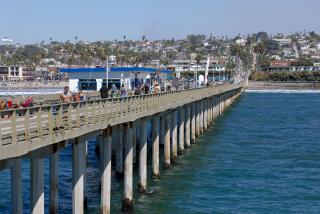Trying to Get Back on an Even Keel : Salvage: Workers are still trying to refloat the Princess Louise, which capsized mysteriously at San Pedro.
- Share via
As he surveyed the long, rusty hull of the once-majestic Princess Louise, naval architect Alfonso M. Sotres offered a landlubber’s explanation for both the ship’s demise and its troublesome salvaging in shallow waters off San Pedro.
“It is a very old ship,” he said.
The 1921 cruise ship, which mysteriously sank in minutes last Oct. 30, has also rested on its side for months in a Terminal Island shipyard. And as its $1-million salvaging effort continued late into the evening Wednesday, no one was making any promises about when, or if, the 330-foot former floating restaurant will be righted.
Salvage crews have been on the job for more than two months and are still mindful of failures to raise the vessel. Early this month, for example, they confidently predicted they were within hours of raising the ship only to see their plans dashed by miscalculations. So now, no one is talking deadlines.
“We’re still working. Everything is going well. But we don’t know when it will happen,” said Sotres, the slight, soft-spoken director of the salvaging effort.
Although huge cranes and broad-shouldered workmen stood at the ready, the salvaging of the 2,400-ton vessel has still hinged on brains, not brawn, on specialized computer models, rather than heave-hos.
“We ran about 100 different models on the computer before we found one that should work,” said Sotres, who is directing the salvage effort by Trinav Shipping Ltd. of Vancouver, Canada, ironically the ship’s original home port.
The salvage effort is being paid for by Southwest Marine, until insurance claims are settled, because the Princess Louise was berthed at the company’s terminal at the time of the sinking.
Several weeks ago, a simple plan to raise the vessel failed, despite the computer’s analysis, when salvage crews overestimated the ship’s seaworthiness. That plan called for patching the ship’s hull, pumping it free of seawater, and relying on the vessel’s own buoyancy to eventually bring it upright.
But years of remodeling the ship’s ornate interior left its compartments too large, too riddled with holes, for the plan to work. “The compartments had to be watertight and airtight. They were neither,” said Sotres. When that plan failed, Sotres returned to the computer and developed the salvaging plan that may finally succeed in raising the vessel at Terminal 241 of Southwest Marine Inc.’s shipyard.
Using divers to thread the ship’s hull with 46 carefully placed steel cables, salvage crews secured the vessel to an adjacent barge. Then, using high-pressure water pumps to empty both the barge and ship’s ballast tanks of seawater, crews gradually increased the tension on the cables and simply waited for the tides to slowly raise both the barge and vessel.
The process, beginning at 2:20 p.m. on Tuesday, was expected to right the ship by high tide that evening. But as darkness fell Tuesday, the Princess Louise was still resting on its side.
About 6:30 a.m. Wednesday, divers returned to the shallow waters of Berth 241 to secure the cables, and the salvage effort began anew. The ship continued to right itself on Wednesday as anxious crews prepared for another long evening.
When and if the ship is again floating upright, plans call for it to be patched for towing to waters a mile off the Palos Verdes Peninsula. There, just north of the Point Vicente lighthouse, salvage crews will sink the vessel so it can be used as an artificial reef for fishing and diving.
Just when that will happen, however, also is uncertain. Patching the vessel, according to Sotres, should take no longer than two days, but he is careful to add that earlier deadlines also have come and gone without success.
But even if the vessel is ready for towing on Friday, state Fish and Game officials, who will take charge of the vessel once it is sunk, said they do not want the ship out to sea before next week.
On Friday, officials said, they plan to meet in San Diego with the U.S. Navy’s Seal divers. “We’re consulting with them to get their assistance in opening up the hull of the ship to make it safer for divers. As it is, it needs more holes for divers,” said Kimberly McKee, a state marine biologist.
The vessel’s final voyage, McKee said, also will not take place this weekend. “We’ve already made it clear we do not want it towed this or any other weekend when the harbor is crowded.”
More to Read
Sign up for Essential California
The most important California stories and recommendations in your inbox every morning.
You may occasionally receive promotional content from the Los Angeles Times.













